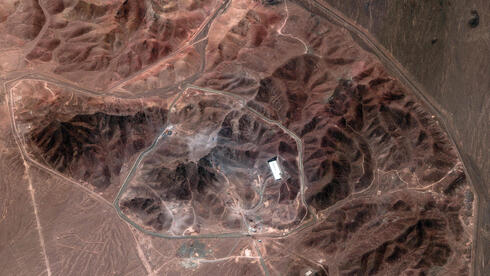By Ynet
New satellite images published in the New York Times on Monday showed activity around Iran’s Fordow nuclear facility following U.S. airstrikes, including road reconstruction and heavy machinery operating near damaged areas. The images taken by Maxar Technologies reveal cranes and excavators working around ventilation shafts and blast craters caused by last week’s airstrikes, which targeted Fordow, Natanz and Isfahan. One image shows vehicles clustered near northern shafts above the underground complex. Maxar analysts said the imagery indicates “a flurry of activity at the heavily fortified facility built deep inside a mountain.” Joseph Bermudez, a senior fellow at the Center for Strategic and International Studies, told the outlet the images likely show Iranian crews assessing the damage. “It appears that they’re evaluating the hole, evaluating how deep it went,” he said, adding that the photos suggest a “process of investigating what happened” rather than immediate reconstruction. Peter MacDonald, director at Viper Applied Science, a U.S.-based firm specializing in blast engineering, said Iran appears to be evaluating the impact rather than launching any meaningful repair effort. Despite the damage, some repairs may already be underway. The satellite imagery shows a large crater near the Fordow entrance was filled in by June 27, though experts say there’s no indication the facility has resumed operations. “You would expect to see more vehicles, different types of vehicles,” Bermudez noted. David Albright, a former weapons inspector and head of the Institute for Science and International Security, said Saturday’s images show that “the Iranians are actively working at the two MOP impact sites penetrating the ventilation shafts.” He added the work could involve backfilling craters, assessing structural damage, or performing radiological tests. Get the Ynetnews app on your smartphone: Google Play: https://bit.ly/4eJ37pE | Apple App Store: https://bit.ly/3ZL7iNv Fordow was struck overnight between Saturday and Sunday by 12 GBU-57 “bunker-buster” bombs dropped by B-2 stealth bombers. According to Gen. Dan Kane, chairman of the Joint Chiefs of Staff, two bombs were used to blast through concrete covering the shaft openings, followed by five more bombs at each point. Kane said the bombs entered the shafts at over 1,100 kmph (700 mph) and detonated deep inside what he called “the mission space.” One pilot reportedly told him the explosion was “the brightest light” he had ever seen, lighting up the night sky like daylight. While U.S. President Donald Trump declared Monday morning that the U.S. had “completely destroyed” Iran’s nuclear infrastructure, some nuclear experts and intelligence officials have expressed caution, suggesting that while damage was extensive, the facilities may be repairable. On Sunday, The Washington Post reported that U.S. intelligence intercepted private Iranian conversations indicating the airstrikes were “less destructive than expected.” The White House swiftly rejected the story, accusing the outlet of promoting “criminal leaks taken out of context.” U.S. Press Secretary Karoline Leavitt dismissed the idea that anonymous Iranian officials could assess damage “beneath hundreds of meters of rubble,” reiterating that “Iran’s nuclear weapons program was destroyed.” Follow Ynetnews on Facebook | Twitter | Instagram | Telegram
